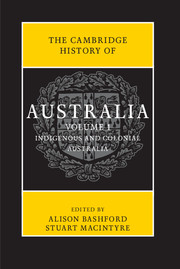Book contents
- Frontmatter
- Contents
- Abbreviations
- List of maps
- List of figures
- List of tables
- Notes on contributors
- Map
- Preface
- Introduction
- PART I
- PART II
- Further reading
- Chronology
- Index
- Frontmatter
- Contents
- Abbreviations
- List of maps
- List of figures
- List of tables
- Notes on contributors
- Map
- Preface
- Introduction
- PART I
- PART II
- 9 Religion
- 10 Culture and media
- 11 Science and medicine
- 12 Society and welfare
- 13 Gender and sexuality
- 14 Indigenous Australia
- 15 Class
- 16 The economy
- 17 Government, law and citizenship
- 18 Education
- 19 The environment
- 20 Travel and connections
- 21 Security
- 22 Australia, Britain and the British Commonwealth
- 23 Australia in the Asia-Pacfic region
- 24 The history anxiety
- Further reading
- Chronology
- Index
12 - Society and welfare
from PART II
Published online by Cambridge University Press: 05 November 2013
- Frontmatter
- Contents
- Abbreviations
- List of maps
- List of figures
- List of tables
- Notes on contributors
- Map
- Preface
- Introduction
- PART I
- PART II
- Further reading
- Chronology
- Index
- Frontmatter
- Contents
- Abbreviations
- List of maps
- List of figures
- List of tables
- Notes on contributors
- Map
- Preface
- Introduction
- PART I
- PART II
- 9 Religion
- 10 Culture and media
- 11 Science and medicine
- 12 Society and welfare
- 13 Gender and sexuality
- 14 Indigenous Australia
- 15 Class
- 16 The economy
- 17 Government, law and citizenship
- 18 Education
- 19 The environment
- 20 Travel and connections
- 21 Security
- 22 Australia, Britain and the British Commonwealth
- 23 Australia in the Asia-Pacfic region
- 24 The history anxiety
- Further reading
- Chronology
- Index
Summary
Despite the prominence of the bush and the bushman in the national imagination, Australia at the beginning of the twentieth century was one of the world's most urbanised nations. It was most remarkable, the American scholar Adna Weber observed, that the greatest centralisation of population occurred ‘in that newest product of civilization’. The capital cities were home to up to 40 per cent of each State's population, a proportion that would stabilise at more than 60 per cent by mid-century. Although Indigenous people have always been more evenly spread over the country, in the second half of the twentieth century they too followed the drift to the cities, with just over 30 per cent living in urban centres by 1996. Described rather harshly by the poet A.D. Hope as ‘teeming sores’ sitting ‘timidly on the edge of alien shores’, the capital cities provided an environment in which the descendants of the highly mobile immigrants who had populated nineteenth-century Australia were able to build more settled communities. Absorbing both those retreating from rural life, and successive waves of migration from overseas, these cities projected an image of egalitarianism while they tolerated degrees of inequality that made it increasingly difficult to distinguish Australia's social structure from that of other advanced capitalist nations.
The increasing tendency of Australians to cluster in cities existed alongside an ideological adherence to the rural ideal. Country living was popularly imagined to produce a healthier, sturdier people, epitomised in the laconic but self-sufficient bushman, or later the Anzac, who came to constitute the typical Australian – an ideal towards which many could aspire despite the dissonance with their lived reality. Beliefs about the superiority of rural living and concerns that ‘empty spaces’ posed a threat to national security led successive governments to promote closer settlement schemes designed to reverse the urbanising trend. In the early years of the century large estates were broken up, laying the basis for ambitious schemes to put returning soldiers on the land after World War 1, but the problems of farming relatively small blocks in a harsh environment defeated most.
- Type
- Chapter
- Information
- The Cambridge History of Australia , pp. 284 - 307Publisher: Cambridge University PressPrint publication year: 2013



